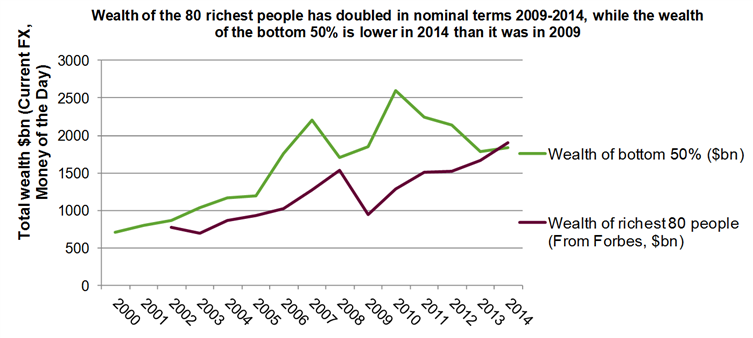This was one of the conclusions reported by Oxfam in January 2015 tying in with Credit Suisse’s Global Wealth Report for 2014, which showed that the 0.7% of the world’s people with assets more than $1m controlled 44% of all the world’s wealth.
The Oxfam report goes on to show that in 2010, the very richest of the global top 1%, the billionaires on the Forbes list, had a net wealth of £1.3tn. By 2014 this had increased by 50% to $1.9tn. During the same period the poorest half of the world saw their total wealth decline, to lower than it was in 2009. Just 80 people now have the same wealth as 3.5bn people; the bottom half of the world’s population.
Source: Oxfam
Recent research of tax data by Emmanuel Saez of the University of California Berkeley and Gabriel Zucman of the LSE, shows that in the USA, the top 0.1% (160,000 families) are worth an average $73m each and hold more than 20% of all US wealth. The bottom 90% of America’s people (145 million families) own $83k each and the same total wealth.
Robert Peston, the BBC’s economics editor points out that there are all sorts of reasons why such increases in inequality are troubling, and not just for those at the bottom of the income and wealth pyramid. Amongst these are a couple of fundamentals to us all being able to enjoy life on the planet regardless of income.
- Firstly, aspirational people on lower incomes have massive incentives to take on too-great debts to support their living standards – which exacerbates the propensity of the economy to swing from boom to financial-crisis bust
- Secondly, the poor in aggregate spend more than the rich (there are only so many motor cars and yachts a billionaire can own, so much of the super-rich’s wealth sits idle. as it were), and therefore growth tends to be faster when income is more evenly distributed.
So, as Peston concludes, “there can be little equality of opportunity in a world where there is the kind of inequality of outcome we haven’t seen since the early decades of the last century.”
There are also more frightening consequences. The Worldbank projects that by 2050 the global population will increase to 9.5m, up 32% on the 7.2m in 2014. On current trends more and more wealth will be owned by fewer and fewer people. This will have its own impact on the economic dynamics of populations, incentivising further the osmotic like migration pressure from poorer to richer regions and nations. More worryingly it will embolden further those who advocate violent alternatives and sell false hopes to the poor majority. This impacts us all, not least the 1% who have so much more to lose than the other 99%.
As the line in George Bernard Shaw’s Major Barbara asks “What price salvation?” Whatever the answer, it will need to be paid…




